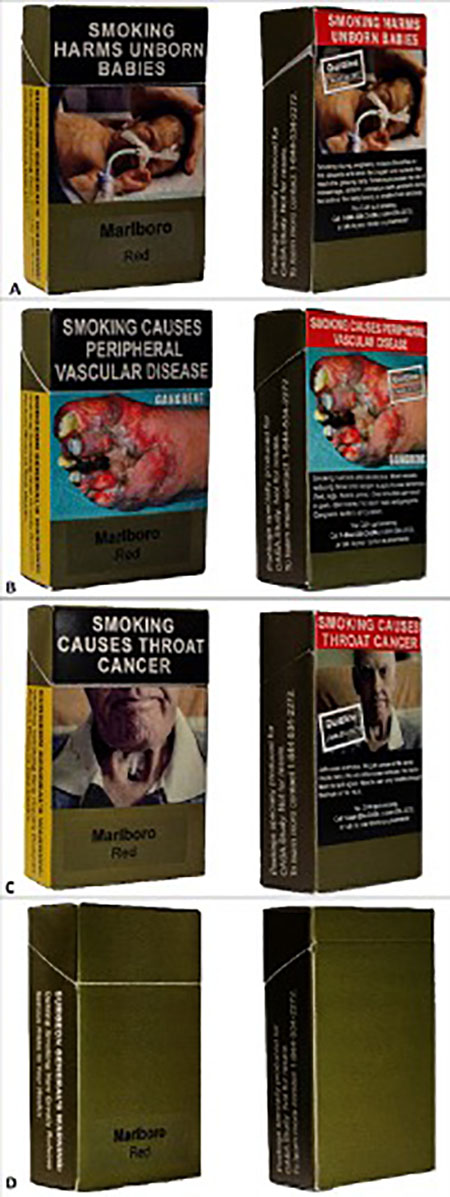Graphic Warning Labels on Cigarette Packaging Changes Perceptions
Smokers in a randomized clinical trial were more likely to recognize the negative consequences of tobacco and consider quitting
Published Date
By:
- Yadira Galindo
Share This:
Article Content
Purchase a pack of cigarettes in Australia and be prepared to be accosted with graphic warning labels depicting the dangers of tobacco use — including images of gangrene of the foot, a newborn with a breathing tube and throat cancer.

Participants were randomized to receive their cigarettes in one of three pack designs: a blank pack, a standard commercially available U.S. pack, or a package with a graphic warning label used on cigarette packs in Australia (under license from the Australian government).
“Graphic warning labels are used in more than 120 countries to counter marketing that promotes cigarette smoking. We wanted to know what effect such cigarette packaging would have on United States smokers,” said David Strong, professor at the Herbert Wertheim School of Public Health and Human Longevity Science at University of California San Diego.
Graphic warning labels were mandated by the United States Congress in 2009 but implementation has been stopped pending the outcome of legal challenges to the law by the tobacco industry.
In a paper published online in JAMA Network Open on Aug. 4, 2021, Strong and colleagues at UC San Diego Moores Cancer Center, California State University San Marcos, San Diego County Public Health Services, and San Diego State University, demonstrated that graphic warning labels are effective reminders of the negative health consequences of smoking.
“Graphic warning labels caused daily smokers in the United States to perceive cigarettes to be less positive and it increased their concerns about the health effects of smoking on both themselves and their loved ones,” said corresponding-author John P. Pierce, Distinguished Professor at the Herbert Wertheim School of Public Health.
The study manufactured special cigarette packs that incorporated the graphic warning labels used on cigarette packs in Australia (under license from the Australian government). Study participants were 357 smokers living in San Diego who agreed to purchase their preferred brand of cigarettes from a study website. Participants were randomized to receive their cigarettes in one of three pack designs: in package with a graphic warning label, with a blank pack, or in a standard commercially available U.S. pack.
During the study, participants were queried by interactive text messaging about concerns over health risks and about their perceptions of the most recent cigarettes that they smoked. Changes in consumption and smoking status were assessed at the end of the three-month intervention.
Participants who received cigarettes in the standard pack or a blank pack had no change in their positive perceptions of their cigarettes, while smokers randomized to the graphic warning label arm perceived their cigarettes less favorably. Health concerns increased in all three groups, likely due to the intervention that made them think about health consequences more often, said the study authors.
"While these labels make smokers more likely to think about quitting, it did not make them more likely to make a serious quit attempt, nor was it sufficient to help them quit their nicotine addiction. Thus, graphic warning labels are an integral component of tobacco control strategies but they are only one tool for governments to reduce the societal costs from the death and disease caused by tobacco smoking," said senior-author Karen Messer, professor of biostatistics at the Herbert Wertheim School of Public Health.
Co-authors include: Minya Pu, Matthew D. Stone, Eric C. Leas, Jesica Oratowski, Elizabeth Brighton, Samantha Hurst, Sheila Kealey, and Ruifeng Chen, all of UC San Diego; Kim Pulvers, CSU San Marcos, Adriana Villaseñor, San Diego County Public Health Services; and Claudiu V. Dimofte, San Diego State University.
This research was funded, in part, by the National Cancer Institute (RO1 CA190347, RO1 CA234539) and Tobacco-Related Disease Research Program grant (28DT-0005).
Disclosures: Strong reported receiving grants from the National Institutes of Health during the study. Leas reported receiving grants from the National Cancer Institute during the study.
Share This:
You May Also Like
Stay in the Know
Keep up with all the latest from UC San Diego. Subscribe to the newsletter today.



